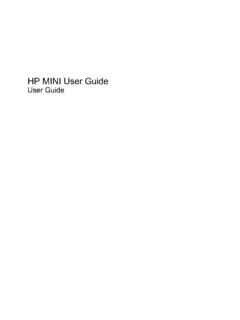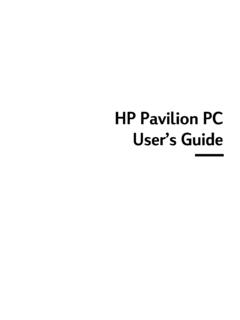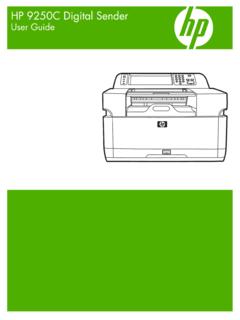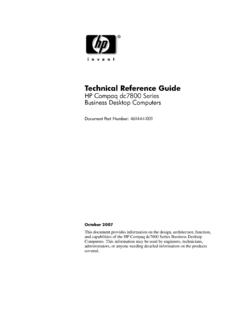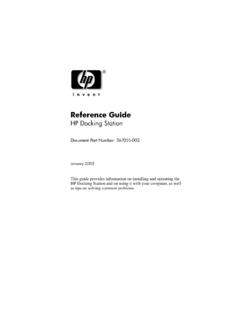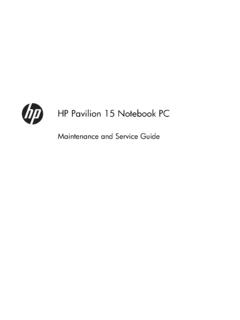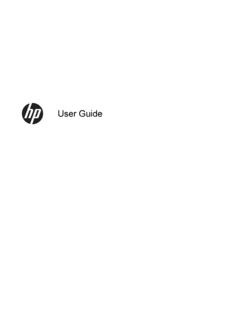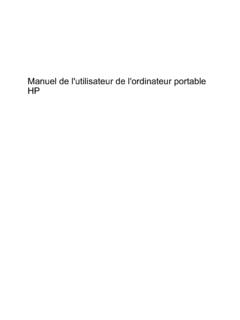Transcription of PC Troubleshooting and Maintenance Guide
1 PC Troubleshooting and Maintenance Guide The only warranties for HP products and services are set forth in the express warranty statements accompanying such products and services. Nothing herein should be construed as constituting an additional warranty. HP shall not be liable for technical or editorial errors or omissions contained herein. HP assumes no responsibility for the use or reliability of its software on equipment that is not furnished by HP. This document contains proprietary information that is protected by copyright.
2 No part of this document may be photocopied, reproduced, or translated to another language without the prior written consent of HP. Hewlett-Packard Company Box 4010 Cupertino, CA 95015-4010 USA Copyright 2005 2006 Hewlett-Packard Development Company, This product incorporates copyright protection technology that is protected by method claims of certain patents and other intellectual property rights owned by Macrovision Corporation and other rights owners. Use of this copyright protection technology must be authorized by Macrovision Corporation, and is intended for home and other limited viewing uses only unless otherwise authorized by Macrovision Corporation.
3 Reverse engineering or disassembly is prohibited. Apparatus Claims of Patent Nos. 4,631,603, 4,577,216, 4,819,098, and 4,907,093 licensed for limited viewing uses only. Microsoft and Windows are registered trademarks of Microsoft Corporation. HP supports lawful use of technology and does not endorse or encourage the use of its products for purposes other than those permitted by copyright law. The information in this document is subject to change without notice . PC Troubleshooting and Maintenance Guide iii PC Maintenance .
4 1 Creating Data Backup Creating System Recovery Discs ..1 Removing Unused Running the Disk Cleanup Program ..1 Running the Disk Defragmenter Checking for Hard Disk Drive Errors ..2 Understanding Hard Disk Drive Space ..2 Recommended Maintenance Schedule ..3 Troubleshooting PC Problems .. 4 Video ..5 CD and DVD Drives ..5 Display (Monitor) ..7 Hard Disk Drive ..8 Hardware Installation ..8 Internet Access ..9 Keyboard and Mouse ..11 Miscellaneous ..14 Table of Contents iv PC Troubleshooting and Maintenance Guide Repairing Software Problems.
5 15 Software Repair 15 Restarting Your PC .. 15 Turning Off Your PC .. 15 Updating Drivers .. 16 Microsoft System Restore .. 16 Application and Driver Recovery .. 16 System Recovery 17 Creating System Recovery Discs .. 18 Creating a Recovery Tools 18 Running System Recovery from Recovery 19 Running System Recovery from the Hard Disk Drive .. 19 PC Troubleshooting and Maintenance Guide 1 PC Maintenance This section includes information about tasks you can perform to help ensure the trouble-free operation of your PC, and to ease the recovery of important information on your PC should problems arise in the future.
6 Creating Data Backup Discs You can use the CD or DVD burning software included on your PC to create backup discs of important information including personal files, e-mail messages, and Web site bookmarks. When writing data to a backup disc, you should use software that includes write verification functionality. This verification feature compares the data on your hard disk drive with the data copied to the disc to ensure it is an exact copy. Depending on your disc burning software, you may need to manually enable this feature.
7 Creating System Recovery Discs This is a one-time step that you should perform while your PC is working properly. If you later encounter problems with your PC, you can restore it to its original configuration using the System Recovery discs that you create. Before creating recovery discs, read System Recovery Overview on page 17, and then create the discs as described in Creating System Recovery Discs on page 18. Removing Unused Programs 1 Click Start, and then click Control Panel. 2 Double-click Add or Remove Programs.
8 The Add or Remove Programs window opens. 3 Select the program you want to remove, and click the Change/Remove button. 4 Follow the onscreen instructions. NOTE: Some programs have their own uninstall features. If you cannot uninstall a program from the Control Panel, try using the program to uninstall. Running the Disk Cleanup Program The Disk Cleanup program frees up space on your hard disk drive by removing temporary and unused files (including temporary Internet Files and files in the Recycle Bin). You can run Disk Cleanup manually, or you can set it up to run automatically.
9 Running Disk Cleanup manually 1 Click Start, All Programs, Accessories, System Tools, and then click Disk Cleanup. Disc Cleanup searches for files to delete and calculates how much disk space can be saved. 2 Choose the files to delete by placing a check mark in the check box next to the file types listed. 3 Click OK, and then click Yes to finish deleting the selected files. Scheduling Disk Cleanup to run automatically 1 Click Start, and then Run, and type the following into the open field (note there is a space between the r and the /): cleanmgr /sageset:100 2 Select the types of files that you want removed (for example, temporary files, temporary Internet Files, and the files in the Recycle Bin).
10 3 Click OK to save the settings. 4 Click Start, All Programs, Accessories, System Tools, and then click Scheduled Tasks. 5 Double-click Add Scheduled Task and then click Next. 6 Select Disk Cleanup from the application list and then click Next. 7 Accept the default task name or type a name for the task, select when the task is performed, and click Next. 8 Select the time and reoccurrence (if available), and click Next. Disk cleanup may take a long time, so select a time when the PC is on but not in use. 9 Enter your login name and password and click Next.
